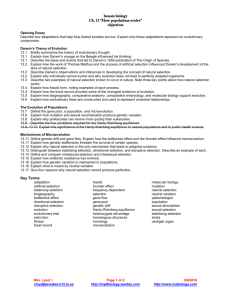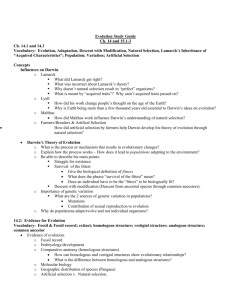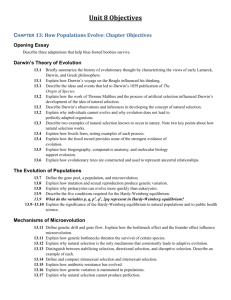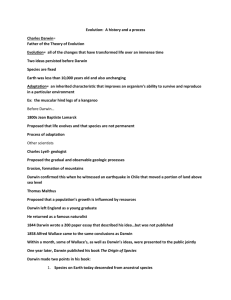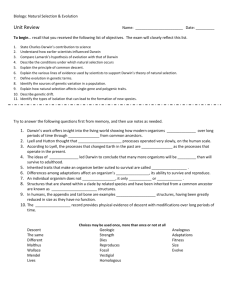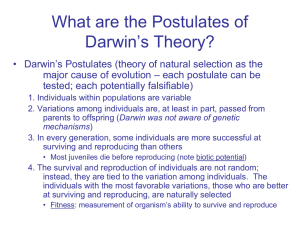CH 13 How Populations Evolve
advertisement
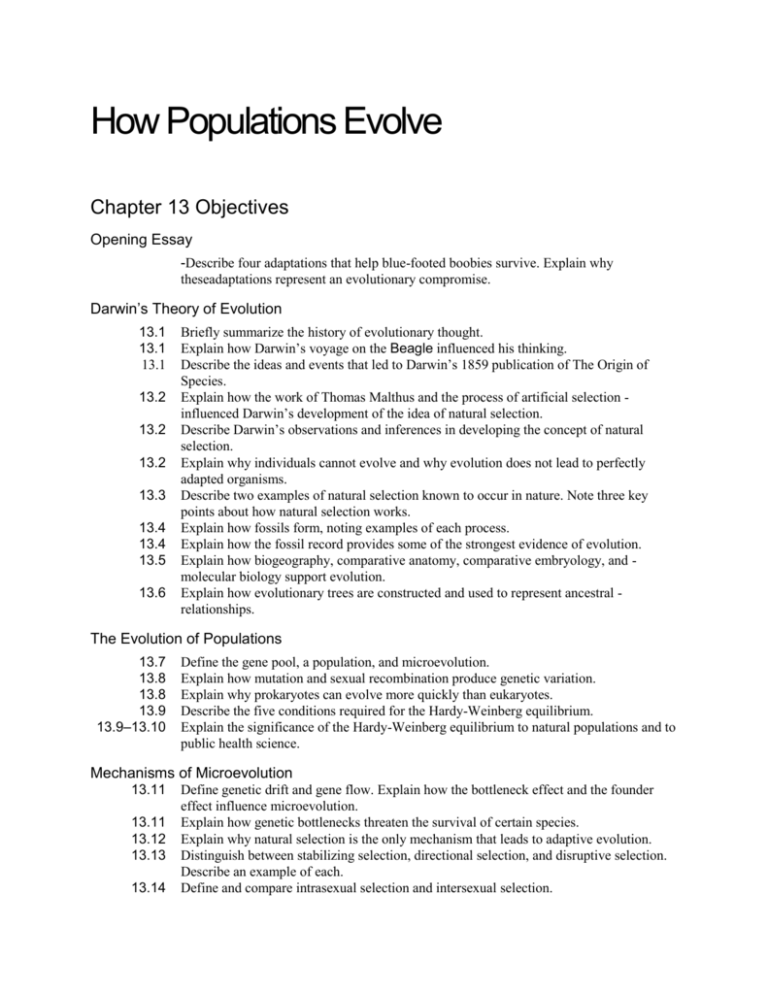
How Populations Evolve Chapter 13 Objectives Opening Essay -Describe four adaptations that help blue-footed boobies survive. Explain why theseadaptations represent an evolutionary compromise. Darwin’s Theory of Evolution 13.1 13.1 13.1 13.2 13.2 13.2 13.3 13.4 13.4 13.5 13.6 Briefly summarize the history of evolutionary thought. Explain how Darwin’s voyage on the Beagle influenced his thinking. Describe the ideas and events that led to Darwin’s 1859 publication of The Origin of Species. Explain how the work of Thomas Malthus and the process of artificial selection influenced Darwin’s development of the idea of natural selection. Describe Darwin’s observations and inferences in developing the concept of natural selection. Explain why individuals cannot evolve and why evolution does not lead to perfectly adapted organisms. Describe two examples of natural selection known to occur in nature. Note three key points about how natural selection works. Explain how fossils form, noting examples of each process. Explain how the fossil record provides some of the strongest evidence of evolution. Explain how biogeography, comparative anatomy, comparative embryology, and molecular biology support evolution. Explain how evolutionary trees are constructed and used to represent ancestral relationships. The Evolution of Populations 13.7 13.8 13.8 13.9 13.9–13.10 Define the gene pool, a population, and microevolution. Explain how mutation and sexual recombination produce genetic variation. Explain why prokaryotes can evolve more quickly than eukaryotes. Describe the five conditions required for the Hardy-Weinberg equilibrium. Explain the significance of the Hardy-Weinberg equilibrium to natural populations and to public health science. Mechanisms of Microevolution 13.11 13.11 13.12 13.13 13.14 Define genetic drift and gene flow. Explain how the bottleneck effect and the founder effect influence microevolution. Explain how genetic bottlenecks threaten the survival of certain species. Explain why natural selection is the only mechanism that leads to adaptive evolution. Distinguish between stabilizing selection, directional selection, and disruptive selection. Describe an example of each. Define and compare intrasexual selection and intersexual selection. 13.15 13.16 13.16 13.17 Explain how antibiotic resistance has evolved. Explain how genetic variation is maintained in populations. Explain what is meant by neutral variation. Give four reasons why natural selection cannot produce perfection. Key Terms adaptation artificial selection balancing selection biogeography bottleneck effect directional selection disruptive selection evolution evolutionary tree extinction fitness fossil record fossils founder effect frequency-dependent selection gene flow gene pool genetic drift Hardy-Weinberg equilibrium heterozygote advantage homologous structures homology microevolution molecular biology mutation natural selection neutral variation paleontologist population sexual dimorphism sexual selection stabilizing selection strata vestigial organ Word Roots bio- 5 life; geo- 5 the Earth (biogeography: the study of the past and present distribution of organisms) homo- 5 like, resembling (homologous structures: structures in different species that are similar because of common ancestry; homology: similarity in characteristics resulting from a shared ancestry) micro- 5 small (microevolution: a change in a population’s gene pool over generations) muta- 5 change (mutation: a change in the nucleotide sequence of an organism’s DNA) paleo- 5 ancient (paleontologist: a scientist who studies fossils) vestigi- 5 trace (vestigial organs: a structure of marginal or no importance to an organism that is the historical remnant of structures that had important functions in ancestors) Student Media Darwin’s Theory of Evolution MP3 Tutor: Natural Selection (13.2) Activity: Darwin and the Galápagos Islands (13.1) Activity: The Voyage of the Beagle: Darwin’s Trip Around the World (13.1) Activity: Reconstructing Forelimbs (13.5) Process of Science: How Do Environmental Changes Affect a Population? (13.2) Discovery Channel Video Clip: Charles Darwin (13.1) Video: Galápagos Tortoise (13.1) Video: Galápagos Islands Overview (13.1) Video: Galápagos Marine Iguana (13.1) Video: Galápagos Sea Lion (13.1) Video: Sea Horses (13.3) BLAST Animation: Natural Selection (13.2) BLAST Animation: Evidence for Evolution: Homologous Limbs (13.5) The Evolution of Populations Activity: Genetic Variation from Sexual Recombination (13.8) Process of Science: How Can Frequency of Alleles Be Calculated? (13.9) Mechanisms of Microevolution Activity: Causes of Microevolution (13.11) Process of Science: What Are the Patterns of Antibiotic Resistance? (13.15) Discovery Channel Video Clip: Antibiotic Resistance (13.15) You Decide: What Can We Do About Antibiotic-Resistant Bacteria? (13.15) Video: Snake Ritual Wrestling (13.12) Video: Albatross Courtship Ritual (13.14) Video: Blue-Footed Boobies Courtship Ritual (13.14) BLAST Animation: Evidence for Evolution: Antibiotic Resistance in Bacteria (13.15)
